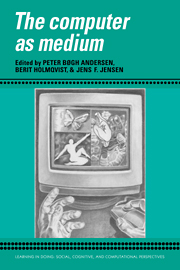Book contents
- Frontmatter
- Contents
- Series foreword
- Preface
- Contributors
- Part I Computer-based signs
- Introduction
- 1 A semiotic approach to programming
- 2 Structuralism, computation, and cognition: The contribution of glossematics
- 3 The shortest way between two points is a good idea: Signs, Peirce, and theorematic machines
- 4 Logic grammar and the triadic sign relation
- 5 Meaning and the machine: Toward a semiotics of interaction
- Part II The rhetoric of interactive media
- Part III Computers in context
- Index
5 - Meaning and the machine: Toward a semiotics of interaction
Published online by Cambridge University Press: 05 October 2010
- Frontmatter
- Contents
- Series foreword
- Preface
- Contributors
- Part I Computer-based signs
- Introduction
- 1 A semiotic approach to programming
- 2 Structuralism, computation, and cognition: The contribution of glossematics
- 3 The shortest way between two points is a good idea: Signs, Peirce, and theorematic machines
- 4 Logic grammar and the triadic sign relation
- 5 Meaning and the machine: Toward a semiotics of interaction
- Part II The rhetoric of interactive media
- Part III Computers in context
- Index
Summary
It is obvious that “symbolic machines” determine a larger and larger part of ordinary life in the kind of social reality we are beginning to experience and to prepare for; it should be just as obvious that this situation calls for a revision of our semiotic “common sense,” the kind of conceptual standards with which we meet our compact social challenges. Neither the interpretative semiotics based on the Peircean tradition (such as Eco 1976), nor the structural semiotics of the Saussurean tradition (such as Greimas 1976) – though both are necessary – seem sufficient to follow up the substantial change induced by the on-going implementation of these machines in our “life world,” probably for the very simple reason that even these often rather sophisticated semiotic elaborations fail to see what a “symbolic machine” actually is and what it can do. This chapter will be devoted to considerations and theoretical work that may prepare the way for at least a partial updating or restating of some of the fundamental issues involved in this dilemma.
On technical objects and machines
If we consider machines as “technical objects,” the semiotic status of this type of objects would be worth considering. I take it to be something like the following. There is a subject actant S and there is a domain of objects D, defined by an intentional relation S-D. S is “doing something” concerning D.
- Type
- Chapter
- Information
- The Computer as Medium , pp. 128 - 140Publisher: Cambridge University PressPrint publication year: 1994



